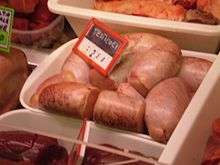Testicle (food)



The testicles of calves, lambs, roosters, turkeys, and other animals are eaten in many parts of the world, under a wide variety of euphemistic culinary names. Testicles are a by-product of the castration of young animals raised for meat, so they were probably a late-spring seasonal specialty,[1] though nowadays they are generally frozen and available year-round.
Cookery
Testicles are cooked in a variety of ways: sautéed and sauced, fricasseed, deep-fried with breading or batter, in pies, poached, roasted, and so on. Before cooking, they are generally scalded, skinned, and soaked in cold water.[2]
Names
Testicles are known by a wide variety of euphemisms, including 'stones', 'mountain oysters', 'prairie oysters', and so on.[1][3] Lamb testicles in particular are often called 'lamb fries' or simply fries (though that may also refer to other organ meats).[4] The French term "animelles" is occasionally encountered. In Spanish speaking countries in Central and South America they are known as huevos de toro, or 'bull's eggs.'. They are known as "koç yumurtası" or "billur" in Turkish.
World variants
Greece, Cyprus, Iran, and Turkey
In Greece, Cyprus, Iran, and Turkey, lamb testicles (Greek αμελέτητα) are often grilled on coals.
United States
In the United States, bull testicles are usually served breaded and deep-fried as an appetizer, under the name "Rocky Mountain oysters".
See also
External links
![]() Media related to testicles (meat) at Wikimedia Commons
Media related to testicles (meat) at Wikimedia Commons
Notes
- 1 2 Laura Mason, in Oxford Companion to Food, s.v. 'Testicles'
- ↑ Prosper Montagné, Larousse Gastronomique, 1938
- ↑ Oxford English Dictionary s.v. 'stone' 11a, 'mountain' and 'prairie oyster' 2
- ↑ Oxford English Dictionary, s.v. 'fry' n2 2b